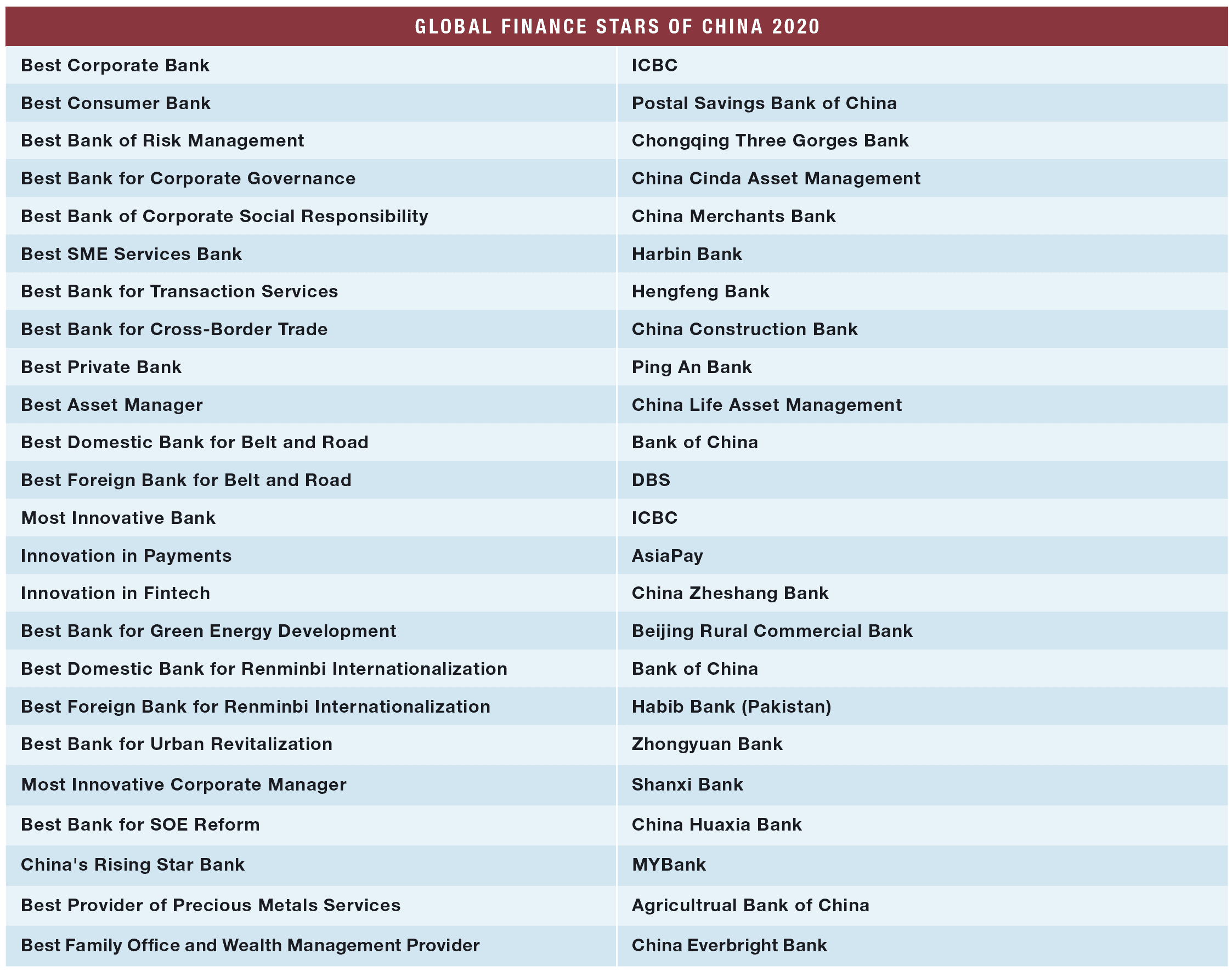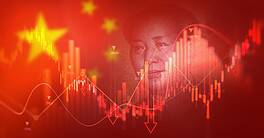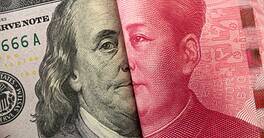For Chinese banks, the disruptions unleashed by the Covid-19 pandemic are hastening automation, new product development and greater emphasis on risk management.

The Chinese banking sector was so financially strong at the beginning of 2020 that a recent report by the China Banking Association assessed the health of the nation’s 51 publicly listed institutions as “remarkable.” That adjective also applies to recipients of this year’s Global Finance Stars of China awards. Covering 24 contest categories—from Best Private Bank to Star of Innovation in Fintech—the winners reflect a remarkably healthy banking industry at the heart of the world’s second-largest economy.
Award recipients include state-run and commercial banks as well as asset management firms.
Two of China’s largest lenders, ICBC and Bank of China, each took home two awards. Also recognized were midsize contenders including Hengfeng Bank, and regional institutions such as Chongqing Three Gorges Bank and Zhengzhou-based Zhongyuan Bank. Each entry was assessed for creative business practices, successful decision-making and standout accomplishments over the past year.
As a group, this year’s winners highlight several China-specific industry trends, including a push for more convenience, more speed and improved customer experiences by means of fintech, online services and smartphone apps. It was a year also marked by increased competition between banks vying for private-banking and wealth management clients, greater emphasis on corporate governance and risk management, and a multiplicity of low-cost credit, investment and transactions products tailored to the needs of small businesses and communities.
Some of these trends overlapped. Chinese banks are adapting to serve the smartphone generation, with a variety of apps and other products for wealth management and investing, says Zennon Kapron, a fintech expert and director of Shanghai-based consultancy Kapronasia.
“The most salient change in China’s banking system in the past five years is the way that the average bank customer interacts with their bank,” he says. “Buying a wealth management product used to involve sitting down with a salesperson at a bank, filling out forms and investing a high minimum sum for a relatively lengthy period of time. Today, China’s consumers can invest as little as ¥1 for as little as a day in only a few clicks.”
Covid and Other Risks
The Covid-19 pandemic accelerated fintech and digital expansion, pushing banks to roll out new contactless payments, deposit methods and even paycheck services. Meanwhile, regulators are encouraging banks to adopt tighter corporate governance as part of an ongoing effort to control financial risk. An “Action Guide” released in August by the China Banking and Insurance Regulatory Commission spelled out a plan to enhance the quality of corporate governance at institutions of all sizes over the next three years.
Banks have also doubled down on their efforts to support urban revitalization, rural development and small to medium-size enterprises. Low-interest loans targeting specific customer groups are being featured in programs designed to cultivate markets for farmers, expand the use of wind power and encourage overseas trade. Domestic banks and some foreign ones continue to support ongoing government initiatives such as the internationalization of China’s currency and Beijing’s Belt and Road overseas trade and development program.
This year’s Stars of China were at the forefront of these and other trends while contributing to the industry’s healthy growth. Combined deposits at 51 stock market–listed banks rose 8.8% in 2019 over the previous year, to 13.4 trillion Chinese renminbi ($1.98 trillion). Over the same period, total lending grew 12% to ¥107 trillion. “Interbank and nonstandard assets continued to decline and the ability to serve the real economy further improved,” the report concluded. “The increasing and stabilizing deposits of the listed banks is remarkable.”
Uncertainties loom, led by the pandemic, which continues to pressure the economy. China’s financial institutions, however, appear to be coming through a supremely difficult year in good health—with the Stars of China setting the pace.

Best Corporate Bank
Industrial and Commercial Bank of China (ICBC)
China’s largest lender and Global Finance’s Best Corporate Bank for the third year in a row, ICBC has made its name as a bank that goes beyond the basics with initiatives that stimulate markets, support specific business sectors and grow the economy. With assets topping RMB30 trillion ($4.45 trillion) according to its 2019 annual report, state-owned ICBC has the muscle to support corporate clients: directly via a broad range of products, electronic banking and international reach; and indirectly through such efforts as bond underwriting for local governments to fund infrastructure and other projects.
Under an initiative launched early this year, ICBC works with the annual Canton Trade Fair, China’s biggest and oldest commercial event—held virtually this time—by offering exhibitors and buyers financing, settlements and other services. ICBC responded to the economic impact of the Covid-19 pandemic by lending more than RMB580 billion to nearly 280,000 Chinese enterprises in impacted areas. The bank’s commitment to corporate clients is also reflected in its support for government directives such as a State Council call to provide financing for manufacturing industry development. Between January and June, ICBC’s loans to manufacturers rose 14% to RMB1.85 trillion—an effort that client executives will no doubt remember.
Best Consumer Bank
Postal Savings Bank of China (PSB)
Postal Savings Bank of China spent more than decade fine-tuning its nationwide operations before forging ahead last year with an initial public offering on the Shanghai Stock Exchange that raised more than RMB32 billion. Investors snapped up the shares in response to PSB’s organizational reforms, sterling financials and commitment to the real economy. But some of the strongest selling points for investors hinge on the bank’s success at sharpening its consumer focus in recent years, thanks to greater data-driven efficiency, channel coordination and seamless wholesale/retail interactions. That transformation helped PSB win this year’s Best Consumer Bank award.
PSB’s 40,000 branches and more than 600 million customers grew from humble origins about 100 years ago. Today, the bank credits its sannong system—serving urban and rural residents alike, as well as small and medium-size enterprises (SMEs)—with helping it play a strong role encouraging economic development.
To support consumer clients, the bank last year doubled its head office IT staff while introducing more IT services, innovation and risk controls. PSB also concentrated more heavily on small-scale internet lending, mobile banking and an open-payment platform aimed at customers in smaller cities. The bank added more than 26 million customers last year, including wealth management and investor clients whose combined assets under management exceed RMB10 trillion, up from RMB800 billion in just two years.
Best SME Services Bank
Bank of Harbin
One size never fits all when it comes to servicing SMEs. Providing financial services for SMEs thus requires flexibility and a willingness to compartmentalize product areas such as lending, with the goal of supporting clients of all shapes and sizes. Bank of Harbin understands these imperatives and has applied what it knows by offering business clients an unusually wide variety of need-specific services, helping it earn this year’s Best Bank for SME Services award. The bank has spent the past 20 years identifying suitable markets and profit points for its SME services, and marketing them to high-quality customers in northeast China. It’s also keen on supporting communities and sustainable business development.
Underscoring the bank’s success are microfinancing services whose combined balances topped RMB178 billion last year. Microfinancing products designed for SMEs accounted for more than 60% of all business customer loans for the past five years. To address the costly hurdles facing SMEs in higher risk categories, Bank of Harbin studies relevant business cycles, to which it matches tailored credit products. Clients can choose from more than 20 financial service products and value-added services.
The bank has also devised an automatic risk-analysis process for approving loans for SMEs, part of what Bank of Harbin calls its “iron triangle,” combining marketing, risk management and products, and thereby offering clients a comprehensive package of services.
Best Bank for Transaction Services
Hengfeng Bank
Hengfeng Bank’s hometown of Jinan is a major stop on one of China’s busiest bullet-train railways, about halfway between Beijing and Shanghai. It’s also the capital of Shandong Province, a colossal hub for manufacturing and international trade. On top of its geographic advantages, Hengfeng has an internal edge in the form of a savvy staff that developed the innovative Hengfeng Fu web-based payment system, the strength of which earns the bank this year’s Best Bank for Transaction Services award.
The payment system uses interface docking to coordinate merchant contract entrustments, offering domestic and international traders rapid customer identity authentication, collections, guarantees and other interbank account payment settlement services. Hengfeng launched the service last year amid a shakeup that placed it under provincial government supervision and made the central government’s Central Huijin agency its largest shareholder. Hengfeng is a joint-stock commercial bank with more than 340 branches nationwide.
Branches in Zhejiang Province have been particularly successful with Hengfeng Fu; in Nanjing, for example, customers include Xingtong Beidou, a provider of computing gear and software for China’s BeiDou Navigation Satellite System. The Hangzhou branch also now handles transactions for the nearly two million members of Zhejiang Financial Assets Trading Center, which annually processes some RMB 300 billion. It’s one of many deals underscoring Hengfeng’s status as a star of transaction services.
Best Bank for Cross-Border Trade
China Construction Bank (CCB)
Blockchain has revolutionized financing, and CCB played a major role introducing the closed-loop, electronic ledger system into the international-trade realm while streamlining business between Chinese and foreign customers. That’s one reason CCB was chosen as this year’s Best Bank for Cross-Border Trade.
CCB operates a blockchain financing platform with a transaction volume exceeding RMB600 billion and a wealth of business services covering domestic letters of credit, forfeiting, international factoring, refactoring and logistics financing. In the first half of this year alone, CCB’s trade financing volume totaled about RMB900 trillion, far surpassing its Chinese peers. The bank’s trade finance division has been investing as much as RMB30 million annually in technology updates.
More than 100 financial institutions in 16 countries and regions have signed agreements to conduct businesses through the CCB blockchain. Easy Pay provides secure and compliant cross-border yuan clearing operations in less than a minute. More than 5,000 foreign trade companies have tapped the low-rate, fast-service Cross-Border Quick Loan program, facilitating an estimated RMB10 trillion in trade loans since 2018. With these services and more, CCB became a blockbuster bank for cross-border blockchain trade.
Best Private Bank
Ping An Bank
Asset management services linked to artificial intelligence have attracted a wave of new clients in recent years, and a prime beneficiary has been the private-banking service of Ping An Bank, this year’s winner of the Best Private Bank honor.
The Shenzhen-based bank’s “intelligent video agents” AI system recently quadrupled in capacity and can now process up to 100 clients simultaneously. Ping An was also a pioneer in automatic investing of private placement products, through which a client can open an account, set terms and specify recurring investment amounts easily through a mobile application. Customers can file insurance fund trust applications online, as well.
These offerings contributed to a run of strong results for Ping An. In the second half of 2020, the bank reported a net profit of RMB13.6 billion, up 11% year-on-year, on revenues topping RMB78 billion. In the December-March period alone, Ping An’s high-net-worth clientele rose 5.2% to 819,800 individuals, while its roster of private-bank customers rose 7.7% to 47,000. Private-banking assets under management climbed 10% to RMB805 billion.
Ping An takes pride in its private-banking formula. It’s based on “global configuration” guidance for worldwide investing; family inheritance support, including assistance for clients’ children seeking higher education abroad; and “exclusive rights and interests” offers that include tax and legal services.
Ping An’s performance in private banking testifies to its ongoing effort to upgrade its technology and improve services.
Best Asset Manager
China Life Asset Management Co.
China’s largest asset manager is a leader in alternative investment strategies, reflecting its commitment to domestic infrastructure, energy resources and consumer-class growth. But China Life Asset Management Co. (CLAMC) takes this year’s Best Asset Manager award not only for how much client funds it manages, but how it does so. With RMB3.8 trillion under management, CLAMC is a major component of the China Life Group insurance conglomerate. While the bulk of those assets (83%) are parked in stocks and bonds, a sizable portion of the 17% is alternative investments. CLAMC calls itself an “innovator in the alternative investment field.” Milestones include an investment in Bohai Industrial Investment Fund, the first yuan-denominated industrial fund approved by the State Council. It also invested RMB10 billion in the Shaanxi Coal and Chemical debt-to-equity fund, the first such project by a domestic insurance company.
CLAMC has also established China’s first urban infrastructure bond plan, backed a natural gas pipeline and supported a public-private partnership project for a subway in Qingdao. Altogether, the firm invested more than RMB200 billion in various engineering projects including roads, bridges and pipelines. The firm has set the bar higher by getting behind the alternative investments that are playing an increasingly significant role supporting China’s economic growth.
Best Domestic Bank for One Belt, One Road
Bank of China
The city of Ejin Qi in westernmost Inner Mongolia recently joined a growing list of international centers for Beijing’s Belt and Road trade and development initiative. The hub will facilitate commerce between China and a remote area of Mongolia with support from a new branch of the Bank of China (BOC), recipient of this year’s Best Domestic Bank for Belt and Road award.
BOC’s decision to put down stakes in Ejin Qi highlights its ties to the thousands of Chinese companies actively participating in Belt and Road. The new branch offers tariff guarantees, international letters of credit and trade financing. Another busy center for domestic companies doing Belt and Road business is BOC’s Shanghai branch. Since the 2013 launch of the Shanghai Free Trade Zone, the branch has opened some 15,400 accounts. Last year, it provided export credit support for China Construction Co.’s project to build a business district in Egypt’s New Administrative Capital. BOC is also facilitating Belt and Road business for domestic companies through bond issues; the latest of five offerings since 2015 launched in April on the Hong Kong Stock Exchange. BOC has raised more than $15 billion through bonds issued in several currencies.
Best Foreign Bank for One Belt, One Road
DBS
Indonesia’s national energy strategy called for tapping local resources. China wanted energy-sector contracts in Southeast Asia under Belt and Road. Working with Singapore-based DBS, both parties reached their goals with a 240-megawatt geothermal plant in North Sumatra. The project earned DBS recognition as this year’s Best Foreign Bank for Belt and Road.
DBS has long been active in advising Chinese clients with overseas ambitions tied to infrastructure, transportation and energy, and now has 12 branches across China with eight infrastructure-specialty bankers based in Beijing. In addition to the Indonesian deal, DBS arranged a bridge loan for construction of a $1.25 billion highway connecting northern Laos to China. Last year in Australia, DBS arranged financing for the Moorabool North wind-energy project owned by Chinese wind-turbine maker Goldwind. Between April 2019 and March 2020, DBS reported securing two new financial adviser mandates while executing six existing contracts in four Belt and Road countries.
Most Innovative Bank
ICBC
For many banks whose clients have been affected by Covid, crisis has encouraged innovation. In China, ICBC leads its peers in crisis-sparked innovation, making it this year’s Most Innovative Bank.
ICBC responded early in the outbreak with contactless features such as online card password modification and retrofitted teller windows. It stepped up mobile payment services that allow internet-enabled grocery shopping, paycheck issuance and safe commuting. ICBC teamed up with mobile services Alipay and WeChat to streamline online deposits, adding about one million bank customers and RMB4 billion in new deposits, and it teamed up internet-only lender XWBank to provide contactless credit services.
Even before the pandemic, ICBC had established itself as a leader in digital innovation, creating more than 3,700 app-related products over the past few years to help clients navigate government services, obtain health care, pay tuition and manage social security benefits. Some 150 courts around the country are connected to the bank’s Judicial Affairs Management Cloud, and nearly 10 million clients used ICBC’s electronic payment system for public transportation in the first half of this year.
But the pandemic was a catalyst for a variety of new services, including some for small businesses, such as facial recognition for credit inquiries and foreign exchange settlements. Based on its track record and its initiatives during the crisis, expect ICBC to continue to innovate.
Star of Innovation in Payments
AsiaPay
Now deep in the digital age, financial insitutions are racing to adopt faster, more effective and more convenient payment solutions. And while most can claim a measure of success, AsiaPay—this year’s winner of the Star of Innovation in Payments award—stands out in both China and the rest of Asia.
Merchants can now deploy an AsiaPay chatbot on social media platforms that provides a digital assistant for day-to-day transactions without extra hardware. AsiaPay’s Payment Analytics 2.0 service helps merchants understand payment-transaction data through online streaming and visualization platforms. AsiaPay also boasts an “eWallet collection” service that provides seamless solutions to merchants and consumers who make purchases with any of the region’s most popular electronic wallet features, including Alipay, WeChatPay, LinePay, Maybank QRPay and UnionPay QR.
The influence of Hong Kong–based AsiaPay, which just turned 20 years old, has accelerated since 2018, when it joined a global payments community tied to EMVCo., the consortium that maintains a universal card-payments standard. Today, the firm operates in more than 16 countries and offers more than 100 payment methods in 144-plus currencies. Its many client accolades include praise from software giant Oracle, for its “seamless and ceaseless operational efficiency.”
Star of Innovation in Fintech
China Zheshang Bank
In the early days of blockchain, most Chinese bankers were curious but also cautious. China Zheshang Bank (CZBank) quickly saw its value, and in 2019 rolled it into a systemwide fintech development strategy that now earns it recognition as Star of Innovation in Fintech.
CZBank is the rare institution that has woven fintech into its institutional fabric. What had been its Information Technology Department is now the Fintech Department. The bank also operates a Blockchain Technology Application Institute, works with researchers at Zhejiang University and applies fintech to strengthen exports of innovative technologies.
A CZBank accounts-receivable chain platform serves more than 20,000 users whose cumulative issues top RMB339 billion. More than 3,000 major enterprises use the platform, including power distributor State Grid Corp., automaker Geely and telecom giant China Mobile. As of April, the bank had registered 16 patents related to blockchain. CZBank’s platform is the basis for China’s first mobile digital bill of exchange and accounts receivables management system, which aims to eliminate many of the risks inherent in traditional offline supply-chain transactions.
Fintech applications and platform-based genes should drive the bank’s operations and “redefine business models based on customer experience and value creation,” CZBank President Xu Renyan recently said. By deepening its use of blockchain.
Best Bank for Green Energy Development
Beijing Rural Commercial Bank
“Beijing Blue” is an increasingly familiar color over the capital city, where a “go green” campaign encourages cleaner air promoting low-emission vehicles, heat-conserving building techniques and wind power. Among the campaign’s leaders is Beijing Rural Commercial Bank (BRCB), selected as this year’s Best Bank for Green Energy Development.
BRCB serves both urban and less developed sections of municipal Beijing. Its influence also extends into rural Hebei Province nearby, where the bank has developed a green credit system and supports a clean-air campaign, scenic developments and environmentally friendly companies.
An important new step for BRCB was announced on June 30, when the bank and Longyuan Power Group, the country’s largest developer of wind farms, signed an agreement. Few details have been released, but the bank called the partnership “an opportunity to actively expand the depth and breadth of cooperation” with Longyuan in Beijing, Hebei and the city of Tianjin, as well as to “strengthen complementary advantages, promote the deep integration of finance and the real economy, give strong support to developing and utilizing green energy and comprehensively push bilateral business cooperation.” BRCB’s role in the wind-power company’s future could mark a significant step up for green growth in China.
Best Domestic Bank for Renminbi Internationalization
Bank of China
International debt-market investors utilizing China’s yuan-denominated Panda bonds rely largely on Bank of China (BOC), underscoring its widely recognized status as a champion of the internationalization of the yuan, or renminbi. That makes BOC the winner of this year’s Best Domestic Bank for Renminbi Internationalization award. Last year, BOC was lead underwriter for 19 Panda bond projects worth RMB54 billion, representing 40% of the market. The bank serves a wide range of customers, with cross-border yuan settlement, lending, bonds, fundraising and wealth management services.
Its signal advantage is the scale of its international yuan business. BOC is the world leader in yuan-based cross-border settlements, which exceeded RMB7.32 trillion last year and topped RMB3.6 trillion in the first five months of 2020. Another advantage is its clearing network, home to about 1,500 interbank clearing accounts. Additional currency expertise is reflected in BOC’s global integration services, which foster cooperation between companies engaged in trade between China and overseas markets. The icing on the cake is BOC’s status as the only Chinese bank that provides independent research services specific to yuan internationalization. The BOC Cross-Border RMB Index and BOC Offshore RMB Index, both closely watched and respected, have helped maintain the bank’s position at the forefront of yuan internationalization.
Best Foreign Bank for Renminbi Internationalization
Habib Bank
The first bank in southern Asia with a physical presence in China, Habib Bank has not only strengthened relations between the two countries but benefited its own bottom line, making it this year’s winner of the Best Foreign Bank for Renminbi Internationalization award.
Karachi-based Habib broke new ground for Asian lenders when it opened branches in the western Chinese city of Urumqi and then Beijing. Last year, it was the only commercial bank at a China-Central Asia forum of the Shanghai Cooperation Organization Interbank Association, and this year it received Chinese regulatory permission to upgrade its Beijing offices to expand use of the yuan for financing Pakistani projects. As Pakistan’s largest lender, Habib has worked closely with Chinese infrastructure builders for years to finance Belt and Road projects, including the Karakoram Highway corridor, the port of Gwadar and power plant installations throughout the country. It also serves as a bridge between Chinese companies and the Middle East.
Habib “has always attached great importance to the Chinese market,” the bank’s Beijing representative, Cheng Wei, recently told China Economic Daily. “China has become an important part of our global strategic layout.”
Best Bank for Urban Revitalization
Zhongyuan Bank
Manufacturing and agriculture are economic mainstays for the two million residents of Henan Province’s Sanmenxia district, where the largest city, Lingbao, is now a target for development support from Zhongyuan Bank. The fact that a relatively small city would attract economic backing from the province’s largest bank underscores the community vision of Zhongyuan, this year’s winner of the Best Bank for Urban Revitalization award.
Most of Zhongyuan’s urban development activity targets much larger urban areas, such as its hometown, the provincial capital of Zhengzhou. But it stepped up to a local government call for support by offering low-interest credit and other services in Lingbao. The city became a focal point after last year’s speech by President Xi Jinping urging both more development and greater environmental protection along the Yellow River, which rolls past Lingbao.
Projects introduced by Zhongyuan over the past year include special bond issues by local governments, so-called green finance bonds for environmental projects and a variety of services tied to tourism, river management and water conservation. As of April, the bank had arranged RMB4 billion in “targeted poverty alleviation enterprise loans.” Having posted a 13%, year-on-year increase in operating income for 2019 to RMB19 billion, Zhongyuan is strong enough to support urban upgrading in Lingbao.
Most Innovative Corporate Merger
Shanxi Bank
Securities regulators are mulling a proposed stock market listing and recruiters are advertising job openings for Shanxi Bank, a brand-new institution that opened this autumn after a surprisingly rapid consolidation that deeply affected residents of Shanxi Province. The government-led multimerger that replaced five small-city banks with a provincial powerhouse was executed so fast and with such far-reaching effects that Shanxi Bank is the favorite for this year’s Most Innovative Corporate Merger award.
Shanxi is the product not of a corporate merger in the strict sense, but of a creative consolidation of financial institutions. Moreover, government officials encouraged the move, which bank shareholders approved in August, under the province’s ongoing reform of local enterprises. The deal was designed to streamline management of debt. Datong Bank took the lead in the restructuring with Jinzhong Bank, Jincheng Bank, Yangquan Commercial Bank and Changzhi Bank. The new bank emerged in September and is now poised to challenge Hong Kong–listed Jin Shang Bank’s status as the province’s biggest institution. Consolidations in Sichuan Province and Inner Mongolia have also been announced in recent months, but none have involved as many banks.
Best Bank for SOE Reform
China Huaxia Bank
There’s no free ride for a state-owned enterprise (SOE)—or any other commercial venture—that makes the hard choice to improve profits through a business overhaul. But the heavy costs of enterprise reform can be managed through financing, smart investment strategies and with the help of advisers like Huaxia Bank, recipient of this year’s Best Bank for SOE Reform honors.
Banks across China are supporting Beijing’s ongoing effort to streamline enterprises owned by state, provincial and local governments. Huaxia got behind SOE reform in a unique way through an investment banking unit that channels investors into equities traded on the Shenzhen Stock Exchange (SZSE). In August, the SZSE and Huaxia signed a strategic cooperation agreement enabling the bank to deepen its ties to equities investing. The deal is expected to funnel more and smarter investments into equities of 157 central government–owned SOEs and numerous SOE subsidiaries listed on the SZSE, which has long encouraged reforms through capital market profit-sharing, risk-sharing and pricing mechanisms. Supporting SOE reform through equities is a new facet of Huaxia’s investment banking business, which handled transactions worth RMB225 billion in the first half of 2020, up 46% year-on-year. Huaxia’s cooperation with SZSE is expected to deepen in the coming year.
China’s Rising Star Bank
MYBank
The financial services industry had not a few doubters five years ago when Ant Financial, an affiliate of e-commerce giant Alibaba, expanded into online banking with its MYBank platform. Some wondered whether online lending to small merchants made commercial sense.
Those doubts have now disappeared and MYBank, whose official name is Zhejiang Online Bank, is profitable while serving more than 20 million small-business and individual accounts nationwide. The bank posted its strongest growth ever in the past year, paving the way for recognition as this year’s Rising Star of the Chinese banking industry.
From its inception, MYBank focused on providing convenient services to grassroots clients including street-side stores, repair shops, professional services providers and farms. Its goal was not runaway profits but to boost the economy while cultivating new business prospects for Alibaba platforms such as Taobao. The effort continues, with the recent unveiling of a digital platform for supply chain finance targeting manufacturers and distributors selling to small enterprises. MYBank posted a net profit of RMB1.2 billion in 2019, up 90% from the previous year, and despite its focus on small-scale lending, it reported a bad-loan ratio of just 1.3% even as business and individual accounts jumped 70% to 20.8 million.
Best Provider of Precious Metals Services
Agricultural Bank of China
Precious-metals trading is popular with millions of investors in China. This past summer, volumes grew so rapidly that regulatory warnings about price volatility prompted some major banks to limit investments in gold, platinum and palladium. Among them was Agricultural Bank of China (ABC), a leading provider of precious-metals information and this year’s Best Provider of Precious Metals Services. ABC has provided a variety of relevant news, market data and expert analysis on its official website for years, helping clients trading on the Shanghai Gold Exchange make decisions. If information is power, ABC clients are generally more empowered than those of other banks, which often use online channels merely for marketing.
Best Family Office and Wealth Management Provider
China Everbright Bank
A new generation of successful professionals are altering China’s family wealth management landscape, encouraging bankers to rethink investment strategies and services for the high-net-worth contingent. China Everbright Bank is quickly expanding to meet the demand, earning it the Best Family Office and Wealth Management Provider award.
Earlier this year, Everbright launched a private-banking division and announced a two-year effort to cultivate a new wealth management business from its current pool of about 100 million account holders. To set the stage, it began working with several major insurance companies and internet platforms to build digital wealth management products. Everbright is targeting a “younger generation” of wealthy clients with technical and managerial careers who “are more likely to accept today’s diversified investment allocation concepts and have shown interest in emerging markets and new technology,” Li Wei, head of Private Banking at Everbright’s Shanghai branch, said at a September forum. The bank’s wealth management products will focus on robust, diversified asset allocation rather than “short-term speculation,” he said.
Everbright reported adding 10 million customers last year and more than doubling its portfolio of products aimed at the affluent. Its strategic plan calls for more products and quality growth as the bank builds its new division into what may be China’s next-generation model for wealth management banking.
Best Bank of Risk Management
Chongqing Three Gorges Bank
When risk management is done well, banks can accept risks for the sake of customers—even entire communities—and end up commended for doing what’s right while also turning a profit. Thanks to its exceptional risk management, Chongqing Three Gorges Bank, winner of this year’s Best Bank for Risk Management award, has profited even while putting resources into anti-poverty and flood-control projects that benefit its community.
To raise living standards for rural communities in the Chongqing region, Three Gorges encourages businesses all along an agricultural supply chain that includes hogs, vegetables, citrus fruit, tea and traditional herbs. The bank’s agriculture-related loan balance rose 20% from 2018, to nearly RMB14 billion last year. It also operates an e-commerce platform, the Three Gorges Mall, through which farmers can sell their products. The bank has provided low-cost credit to help victims of the region’s frequent floods, and companies engaged in flood prevention receive preferential loan rates. Such efforts paid off with a 25% increase in net profits last year.
Best Bank for Corporate Governance
China Cinda Asset Management
The struggles of troubled companies often have their root in poor executive decisions. For a financial services firm cleaning up a distressed company, a commitment to wise and responsible supervision is doubly important. Distressed asset disposals are the primary business of China Cinda Asset Management, which takes Global Finance’s first Best Bank for Corporate Governance award by demonstrating a strong commitment to corporate responsibility and transparency. A quick look at the state-owned Hong Kong–listed firm’s 2019 annual report reveals 31 pages covering corporate governance activities, with names, meeting attendance records and remuneration for each board member, as well as details of risk-management activities, profit-sharing decisions, shareholder rights and executive oversight.
Cinda provides ongoing professional training for directors in areas such as audit supervision and regulatory standards for mainland and Hong Kong companies. Board committees include panels on auditing and personnel, including executive diversity. In the report, Chairman Zhang Zi’ai notes Cinda’s success in improving “the mechanism for evaluating directors” and their “ability to perform their duties diligently and make scientific decisions.” Cinda spent RMB52 billion on distressed asset acquisitions last year. And with more than RMB1.5 trillion in assets under management in 2019, up 1% from 2018, it’s strongly placed to handle complex financial matters related to corporate reorganizations going forward.
Best Bank For Corporate Social Responsibility
China Merchants Bank
Ecological development, financial inclusion and poverty alleviation are a few of the decision-driving issues at China Merchants Bank, winner of the Best Bank for Corporate Social Responsibility award and a newcomer to the Stars of China lineup. China Merchants has been a practitioner for years, through a range of social programs that engage both the bank and its account holders. A dedicated institutional platform services public welfare projects, including networks for charitable giving, natural-disaster relief, poverty alleviation and childcare programs, and it has built public trust by exercising financial transparency in the charity arena.
Last year, China Merchants reported that more than 354,173 regular account holders were participating in its Yue Duo donation system, which deducts a fixed amount each month for the holder’s favorite charity. Projects have funded school libraries, food for poor villages, homes for needy children and health care for elderly veterans.
The bank is also active in environmental causes such as programs to fight desertification by planting trees and designing loan programs to support business sectors like wind energy and medical equipment manufacturing. Giving back to society is in the bank’s blood, China Merchants President Tian Huiyu recently stated in a report on its corporate social-responsibility efforts. “In the future,” he said, “we will keep close in mind our mission and responsibilities, uphold social responsibility based on the concept of ‘take from society, return to society’ and grasp development opportunities” with the goal of “creating sustainable value.”



